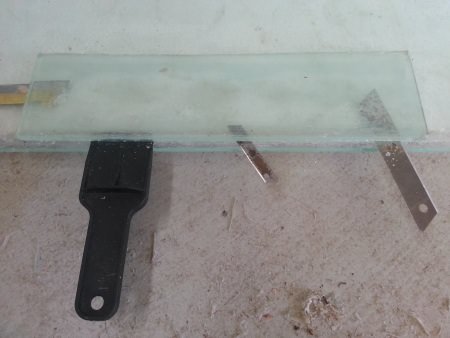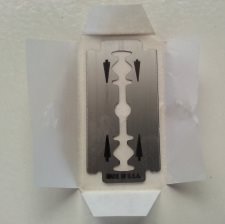| Back to Back Issues Page |
 |
|
The Goldfish Gazette, Issue #083 Repairing Glass Aquariums November 29, 2020 |
Goldfish Care TipsA Free Monthly Resource For Goldfish Enthusiasts In This Issue With the advent of modern glues and sealants, aquarium glass panels were able to be glued together instead of being held in place with frames and waterproof putty. Repairing Glass Aquariums
Removing bottom brace for repositioningSome of us are old enough to remember when aquariums had metal frames that rusted, and waterproof putty that hardened over time, which meant emptying an aquarium was always a gamble as to whether a glass panel would loosen and leak water when the aquarium was refilled.One advantage of this construction type was if the aquarium was placed on a less than perfect surface, the frame and putty would flex and take up any surface imperfections. With the arrival of RTV silicone glue that adheres strongly to glass in the mid 1960s, aquariums could be made without frames, thereby eliminating the rust and leaking problems. Some aquariums do come with a frame of sorts, but the frame is used for decorative purposes, not strength and are harder to disassemble. With the lack of metal frames, the one advantage this type of construction had was gone. Aquarium PlacementFrame-less glass aquariums must be placed on a perfectly flat, level surface and the entire bottom pane should be supported. In most cases, this isn’t possible, which is why many aquariums get broken bottom panes, or at best, a leak develops from a stressed seam. Glass doesn’t bend well.Failure can take place many days after setup. In my case after convincing my Mother she needed a 4-foot (1200mm) aquarium in her lounge on a purpose-built stand, I received a call at work a week after installation reporting water cascading on to the carpet. The bottom pane had cracked. I wasn’t popular and needless to say, the aquarium was returned to the store. What I had failed to do was install a piece of polystyrene under the aquarium, and place the stand on a firm surface. Repairing an all glass aquarium is relatively easy with no special skills required, but because you are going to be using very sharp tools, it isn’t a job for children. Aquarium DismantlingThe first job is to work out what caused the breakage or leakage to avoid a re-occurrence. Failures are rare if an aquarium sits on a flat surface on a piece of polystyrene, the glass is the correct thickness for the size of aquarium and the right RTV silicone glue is used.
Starting the cutting process is the hardest part so don’t rush it. If you can’t get the blade into the glue, apply a small amount of pressure to the broken pane to create a small gap that the blade can be pushed into. I use a slicing motion to cut the glue. Because of the order of assembly, you will also need to remove the front or rear pane and any top support caps if it is a side pane you are replacing. Once the broken pane has been removed, clean up all contact faces spotlessly, removing all old glue with methylated spirits or acetone. Aquarium ReassemblyReassembly must be done on an absolutely flat surface.When the pane is glued into position, there should be no air bubbles in the glue. Any exposed edges should be lightly arrised (polished) to avoid cut fingers when handling the aquarium. This is particularly important if replacing the bottom pane. Use painter’s masking tape to hold side panels in position. Don't rush reassembly; get one pane exactly right before fitting the next. The correct RTV glue to use is the 100% silicone acetic cure type, not the natural cure type. The glue packet usually states that the glue is suitable for aquariums. Amazon carries the Aqueon brand silicone The cure time is slow for this glue, 72 hours for general use but 7 days when used for aquariums.
Comments? Ideas? Feedback? I'd love to hear from you. Just reply to this e-zine and tell me what you think, or what topics you want covered. Next Month's Topic Minor injuries-when NOT to treatwww.facebook.com/aboutgoldfish |
| Back to Back Issues Page |

 The first stage of repair is removing the broken pane.
This is where you find out how strong RTV silicone glue is. I use a double-edged razor blade used in old style safety razors. Insert the blade into the glue between panes and gradually work along the seams until the broken pane can be removed.
The first stage of repair is removing the broken pane.
This is where you find out how strong RTV silicone glue is. I use a double-edged razor blade used in old style safety razors. Insert the blade into the glue between panes and gradually work along the seams until the broken pane can be removed.